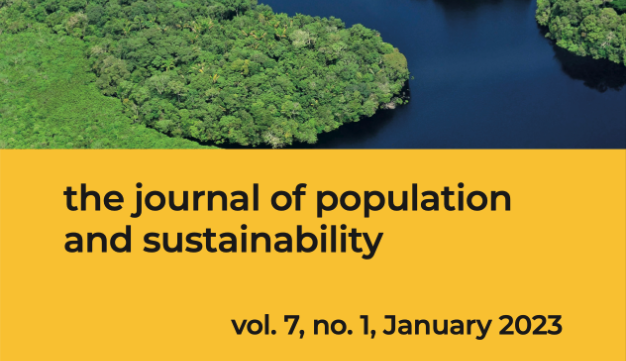
A planet of 8 billion and the future of humanity
The Journal of Population and Sustainability, published by White Horse Press, explores all aspects of the relationship between human numbers and environmental issues.
Population is a complex, multifaceted subject, one that is often neglected and misunderstood in the wider world. We know that population numbers have a significant impact on planetary health and its inhabitants, so there is a real need for high-quality studies looking at these issues.
This is where the Journal of Population & Sustainability (JP&S) comes in. The JP&S is where to go for the latest trends, academic research and in-depth analysis for those who want to understand the issues more comprehensively. The bi-annual journal publishes peer-reviewed and invited material and is edited by David Samways, whose research interests centre around socio-technical practices and environmental sustainability.
While financially supported by Population Matters, the JP&S is editorially independent and welcomes contributions from a variety of perspectives on the role of population in environmental problems. The views and opinions expressed by authors do not necessarily reflect those of the editor, the editorial board or publisher.
The most recent edition was published in January this year – please read on for a brief summary of what’s inside.

An introduction
David Samways opens the latest volume of the JP&S referencing the 15 November 2022 and “8 billion day“, the day the estimated 8 billionth child was born. Noting the positive spin attached to the event by the UN, he comments that, despite growing scientific evidence that population growth has a major part to play in environmental crises, population alarmism has reduced in recent decades while environmental concerns have increased in the same period.
While it is clearly unfair to treat any of the 80 million individual children added to the global population each year as a problem, the ability to provide a good life to everyone whilst simultaneously tackling the environmental crisis becomes ever more difficult as the population grows.
Overshoot: Cognitive obsolescence and the population conundrum
The first article in the journal is by William Rees, bio-ecologist, ecological economist and Professor Emeritus at the University of British Columbia.
Rees argues that the human brain cannot comprehend the ecological crises of our time as cultural and social changes have simply outpaced it, leaving it ‘functionally obsolete’ and unable to process the current crises. Modern society has experienced rapid technological change and represents a fraction of human history; thus it is not equipped to process the complexities of these modern environmental crises.
Considering the problem of population growth, Rees notes that the UN’s complacency, the reductionist simplicity of resistance to advocates of population reduction and, citing Nandita Bajaj and Kirsten Stade’s article also published in this issue, pronatalism are obstacles to rationally dealing with human numbers as a factor in the environmental crisis.”
CHALLENGING PRONATALISM IS KEY TO ADVANCING REPRODUCTIVE RIGHTS AND A SUSTAINABLE POPULATION
The second paper is by Nandita Bajaj, Executive Director, and Kirsten Stade, Communications Manager of Population Balance, a US nonprofit that offers education and solutions to address the impacts of human overpopulation and overconsumption on the planet.
They assert that, while pronatalism is more common than the limiting of reproductive rights worldwide, organisations shy away from touching the subject as they are unwilling to discuss the issue of population growth “due to fear of any association with reproductive coercion”.
We examine the full range of patriarchal, cultural, familial, religious, economic and political pronatalist pressures, and argue that the reluctance to address population as a driver of the ecological crisis serves the very pronatalist forces that undermine reproductive autonomy.”
Family planning progress in 113 countries using a new composite Progress Index
Dr Aalok Chaurasia of the Mewalal Chaurasia Foundation is the author of the third article. His index measures progress in meeting family planning needs against three criteria, provision of permanent methods (male and female sterilisation); provision of modern spacing methods (such as inter-uterine devices, the contraceptive pill, condoms etc.); and expansion of choice in the method of family planning.
Chaurasia finds that progress in meeting family planning demands is unsatisfactory in forty per cent of the countries included in his research, and he notes that in many countries the family planning needs of both men and women are not being met.
Family planning needs to be treated as a development strategy for the realisation of the goal of planned family that is critical to sustainable development and human well-being rather than just an intervention to reduce fertility.”
Aalok Chaurasia
Population and steady-state economy in Plato and Aristotle
The final paper is by Theodore P. Lianos, Professor Emeritus of Political Economy at the Athens School of Economics and Business, Greece. Lianos explores how some of the critical elements of the modern steady-state economic model can be found in the writings of Plato and Aristotle.
Plato in his Laws and Aristotle in his Politics discuss the optimal relationship between population and available land that would give enough wealth to the city and allow the citizens to enjoy the best life. They discuss questions of income inequality and approaches to population control. The guiding thought in these models is what the two philosophers define as the ‘best life’.”
The journal closes with an obituary of Herman Daly, who sadly passed away in October 2022. Herman was a world-renowned Ecological Economist, a member of the JP&S editorial board and a member of the Population Matters’ Expert Advisory Group.
The latest JP&S is the 13th edition, so if you’d like to delve into the archive you can see all previous versions here. Finally, if you’d like to receive the JP&S directly into your inbox twice a year upon its publication, please let us know.



